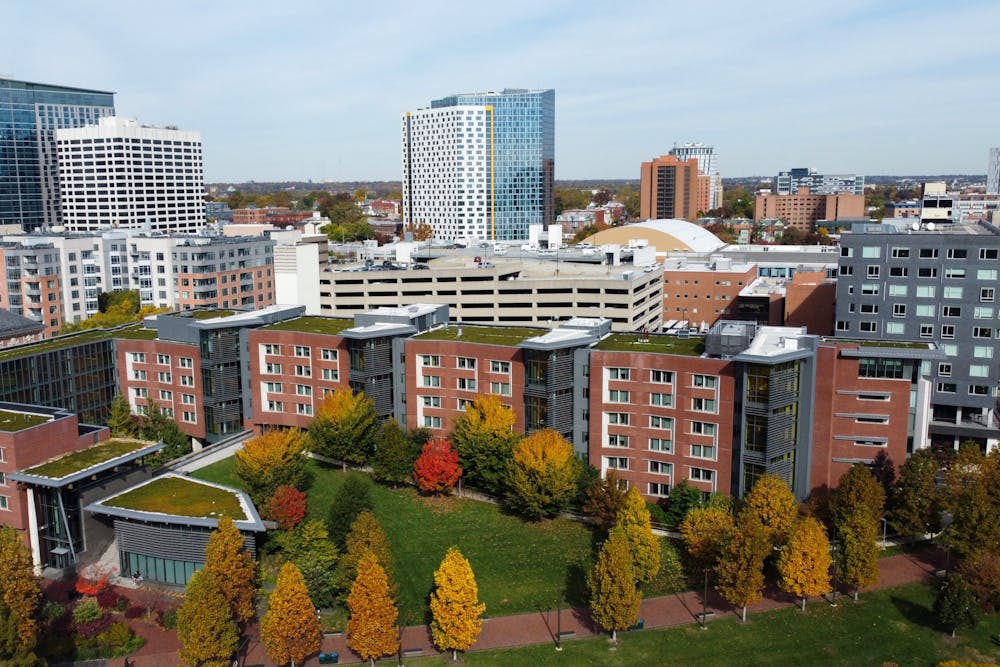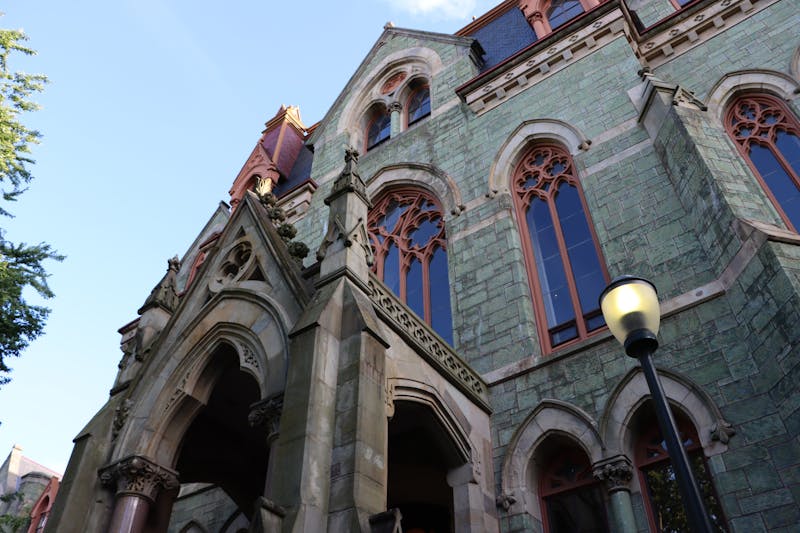
The field by Lauder College House, next to the new performing arts center being constructed.
Credit: Abhiram JuvvadiA stroll down Locust Walk features the usual encounters: masses of people headed to class, loose herds of tour groups, locals accompanied by small dogs, and the occasional wanderer handing out flyers. On that walk, you may now find large fencing surrounding half of Houston Hall and scaffolding shielding much of College Hall. Campus life has jumped into full swing following the skepticism of opening up after two years of pandemic limbo. The people are back, and so is the constant need for construction.
Penn’s effort to always improve is often welcomed with open arms. The Quad renovations, while displacing future first years, are desperately needed following the barrage of mold and heating complaints, and the planned renovation of 1920 Commons is a popular announcement after the recent health violation reports. Although inconvenient, the work dividing the Perelman Quadrangle aims to accomplish the same feat of improving what is already there. However, some recent projects tell a different story. Instead of fixing up the parts of campus that are falling apart, Penn has prioritized being bigger over better.
As a result, green space is disappearing fast. In a city already devoid of nature, Penn is rapidly urbanizing, eliminating the special parts of campus — the parts that do not box you in, but allow you to explore. Whether it is snowing or hot outside, students congregate in the limited green spaces that Penn offers: they sit down for picnics, jump around for a game of spikeball, or lounge on travel hammocks. Because of Penn’s urgent craving for urbanization, this sense of community can now only be found on Hamilton Village, College Green, or Hill Square.
Construction on a new performing arts center next to Hill College House will begin in the near future, covering up more green space in an effort to add rehearsal space. This Gutmann-era proposal is still in the works and reflects a general theme when it comes to Penn’s growth. The university leans toward expansion over improvement of existing buildings — the prime example of this theme transformed on-campus housing a couple years ago.
New College House West — now named Gutmann College House — is notorious for (1) being the holy grail of on-campus housing and (2) upping the on-campus living requirement to include sophomore year. Less considered is the fact that Gutmann College House demolished a green space for students and the surrounding community in order to dazzle visitors with a big project.
Gutmann College House is undeniably spacious, accommodating, and modern, but instead of raising a new building over a park, the older college houses could have been prioritized. Stouffer College House and the Quad need their current renovations, but they could have been addressed a while ago before all the living condition complaints emerged. The high rises also need some of that attention after various recurring flooding incidents. Housing is in no need of expansion, just improvement.
The same can be said for Penn’s dining options. Renovating Commons is a good first step, but Hill House should receive equal attention because it failed the health code inspection just as badly. When the on-campus dining requirement rose from one to two years, dining facilities should have been modernized. That never happened, and now, Penn is scrambling to update its facilities and provide more dining options.
As for academic buildings, the Stiteler Hall and Graduate School of Education merger is much more in line with sustainable expansion on Penn’s campus. It prioritizes space and improves upon existing structures. The construction of Gutmann Hall — yes, it is entirely different from Gutmann College House — fortunately does not cover up green space, but it does reflect the problematic expansion of Penn’s campus which is frequently termed "Penntrification." Another example of this issue is the University City McDonalds, which has been shut down and will soon be crammed into the first floor of a large Penn office building.
Extracurricular-related buildings need their fair share of improvements, too. Performing arts groups compete for rehearsal space between the Platt Student Performing Arts House and Annenberg Center, but is construction of a new performing arts center on the far east end of campus going to help? Projects like the Annenberg Center expansion have a better chance at alleviating practice space issues because they provide faster relief and fix pre-existing issues rather than potentially inventing new ones.
I understand that flashy projects with large dollar signs grab a prospective student’s attention. Everyone wants a school that is academically flourishing and looking to accomplish more, but consider how Penn is steadily changing. What was once a recognizable, open landscape surrounded by academia may soon be a cluttered mass of urbanized buildings. Improving existing structures instead of building new ones is the only way to preserve the Penn that we chose.
C.H. HENRY is a College sophomore studying communication and diplomatic history from Nashville, Tenn. His email address is chhen@sas.upenn.edu.
The Daily Pennsylvanian is an independent, student-run newspaper. Please consider making a donation to support the coverage that shapes the University. Your generosity ensures a future of strong journalism at Penn.
Donate






